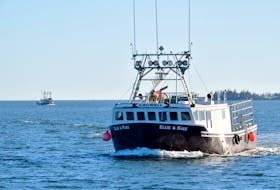SCOTSBURN, N.S. — “I like the outdoors, and I enjoy being active,” said Bob Boardway, his seeing eye-dog Baz at his side.
“And these people are really great,” he adds, gesturing to his travelling companions sitting around the dinner table at the Scotsburn Recreation and Community Centre.
When he’s on the trails, Boardway leaves Baz at home, relying instead on his fellow hikers to envision his surroundings.
“They do a lot of description for me,” he said laughing. “If you know the AMI descriptive channel, that’s what they do for me.”
On Oct. 5, there was a warm meal awaiting Boardway and the rest of the six-person troupe when they arrived at the community centre at 5 p.m. The heaters were switched on, chili was cooking and an old Rankin Family favourite was playing on the stereo.
Not a bad place to be, after a 20-kilometer day.
The hikers started on the Kemptown road in Colchester County on Oct. 4, trekking overland through the Gully Lakes Wilderness Area step-by-step toward Fitzpatrick’s Mountain.

The crew takes a short break on a bridge crossing Meguma Falls. The name ‘Meguma’ comes from the Meguma Terrane, a micro continent that amalgamated with others 335 million years ago to form part of the supercontinent called Pangea. When Pangea started breaking apart 175 million years ago, the Meguma terrane separated from the proto-African continent and migrated across a nascent Atlantic Ocean. With it also came Avalonia, which is believed to have once been attached to what would become Scandinavia and Scotland. Respectively, these two geological terranes from the lower and upper halves of Nova Scotia as it is today, and the Cape to Cape trail traverses both.
“It’s an event to publicize our almost completed trail system,” explained Eric Wilson, a longtime member of the Cape to Cape Commuter trail. He had just finished putting the coffee on when the hikers arrived at the community centre.
“Eventually, it’s going to go from Cape Chignecto in Cumberland, all the way across the highlands to Cape George in Antigonish County,” said Wilson.
The long-distance footpath along the Northumberland Strait has been in the works really since 2003, when it was first envisioned by Dr. Gordon Young. Young, who was among the support staff helping out the hikers, began approaching government officials with the idea of connecting Cape Chignecto to Cape George with a trail that would span Cumberland, Colchester, Pictou and Antigonish counties. In 2008, the trail was officially launched what was then Stonehame Lodge and Chalets on Fitzpatrick Mountain, and the volunteers have been working away at it bit by bit ever since.
“It’s taken us quite a long time to get this where it is,” said Wilson. “Walking the trails in spring and fall, clearing branches and windfalls with chainsaws."
For now, the troupe would be finishing-up their journey in Greenhill on Oct. 6.
“It was great,” exclaimed Elaine Falconer, a field leader certified by the Outdoor Council of Canada.
Falconer was unloading her pack and looking over trail maps spread out on a nearby table. Along with everyone else on the trip, Falconer’s overnight gear was transported for her by support staff so that they only had to carry the essentials for the day:
- Water proof outer layers
- Boots with good traction and support
- TMR radios belonging to Emergency Management Canada
“This hike covers five different fire departments, and we thought it was prudent to let them know what we were doing, in case of an emergency call,” said Falconer, displaying her radio which also had a GPS built in.
“When you’re out in the woods like this, you want to make sure you have everything you need,” said Falconer.
On Oct. 4, the group was taken to Millsville for the night due to inclement weather. The following morning, they were taken back to the trail and the crew backtracked to where they originally intended to stop, at a place on the Cape to Cape trail called McLachlan Bothy.
There they found a few things that the “trail magic” had left behind.
“There was beer hidden at the Bothy,” laughed Pat MacDonnell, another trail leader on the hike. “Must have been the trail magic.”
In fact, it was people like Young and Wilson who were going above and beyond in their role as support staff. They had also left a plastic bag filled with sour keys.
“And chocolate,” laughed Falconer.
By 6 p.m. dinner was served. The crew enjoyed freshly baked bread, chili, rice, and a pumpkin pie while sipping on “trail magic”.
“The people have been amazing,” said Marianne Wyllie who was convinced to join to trek by fellow Haligonian Natalie Parker. “In the last five years I’d heard about the Cape to Cape trail, but I didn’t think it would be this guided and supported,” said Wyllie, who remarked especially that the sight of old growth forest was an experience that she’ll take home with her.

“The old growth hemlock stands were really special,” she said.
The Acadian forest is composed of hemlock and yellow birch, many of which are home to diverse species of lichens which grow generously on bark and branches—a rare sign of air purity and health in the woods surrounding Scotsburn.
“There’s not a lot left in the province and we went through about four of them today.”








